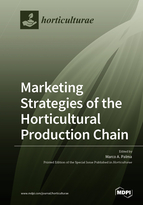Marketing Strategies of the Horticultural Production Chain
A special issue of Horticulturae (ISSN 2311-7524). This special issue belongs to the section "Horticultural Economics, Policy, Business Management and Marketing".
Deadline for manuscript submissions: closed (15 October 2018) | Viewed by 53505
Special Issue Editor
Special Issue Information
Dear Colleagues,
Horticulturae is launching a Special Issue on marketing and economics. We encourage the submission of high-quality papers related to all aspects of horticulture economics, marketing and management including horticulture production of fruits, vegetables and green industry products; adoption of new technologies and production practices; processing, distribution and transportation; marketing and consumer preferences; international trade; policy analysis; food safety; and the role of horticulture in food security, nutrition and health.
Dr. Marco A. Palma
Guest Editor
Manuscript Submission Information
Manuscripts should be submitted online at www.mdpi.com by registering and logging in to this website. Once you are registered, click here to go to the submission form. Manuscripts can be submitted until the deadline. All submissions that pass pre-check are peer-reviewed. Accepted papers will be published continuously in the journal (as soon as accepted) and will be listed together on the special issue website. Research articles, review articles as well as short communications are invited. For planned papers, a title and short abstract (about 100 words) can be sent to the Editorial Office for announcement on this website.
Submitted manuscripts should not have been published previously, nor be under consideration for publication elsewhere (except conference proceedings papers). All manuscripts are thoroughly refereed through a single-blind peer-review process. A guide for authors and other relevant information for submission of manuscripts is available on the Instructions for Authors page. Horticulturae is an international peer-reviewed open access monthly journal published by MDPI.
Please visit the Instructions for Authors page before submitting a manuscript. The Article Processing Charge (APC) for publication in this open access journal is 2200 CHF (Swiss Francs). Submitted papers should be well formatted and use good English. Authors may use MDPI's English editing service prior to publication or during author revisions.
Keywords
- horticulture marketing and economics
- value added horticulture
- consumer preferences
- international trade
- food security
- food safety






